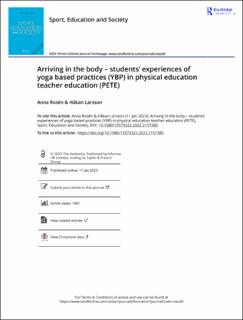| dc.contributor.author | Rosén, Anna | |
| dc.contributor.author | Larsson, Nils Håkan Olof | |
| dc.date.accessioned | 2024-03-15T14:30:46Z | |
| dc.date.available | 2024-03-15T14:30:46Z | |
| dc.date.created | 2023-04-11T14:53:03Z | |
| dc.date.issued | 2023 | |
| dc.identifier.citation | Sport, Education and Society. 2023, Artikkel 2157385. | en_US |
| dc.identifier.issn | 1357-3322 | |
| dc.identifier.uri | https://hdl.handle.net/11250/3122717 | |
| dc.description | This is an Open Access article distributed under the terms of the Creative Commons Attribution-NonCommercial-NoDerivatives License (http://creativecommons.org/licenses/by-nc-nd/4.0/), which permits non-commercial re-use, distribution, and reproduction in any medium, provided the original work is properly cited, and is not altered, transformed, or built upon in any way. | en_US |
| dc.description.abstract | The interest in yoga, mindfulness or similar yoga-based practices (YBP) has grown exponentially in the western world, also within education, including physical education (PE). Although some studies have been conducted on YBP in PE, yoga has not yet been researched in the framework of physical education teacher education (PETE). Using a regional lifeworld approach, the purpose of this article is to investigate how PETE students experience their participation in a YBP didactics unit when it was included in the PETE programme. What thoughts, feelings and bodily sensations were evoked in the students as they explored YBP and their prospects for teaching it themselves? The project involved 13 students during their fifth year in one of Sweden’s PETE programmes. Questionnaires and diaries were used as information sources. Ten of the 13 students were also interviewed. In the phenomenological analysis, the phenomenon of friction ‘showed itself’ to be an essential part of the perceived experiences. Friction was characterised by a tension between an absence of friction, which describes experiences of participating in YBP smoothly, and the presence of friction, which included experiences of resistance. The students also oscillated between experiences of I-here and now, and Me-my future teaching profession. At least to some extent, the YBP that was practised during the course changed the students’ views of what education in ‘human in motion’ can be by discovering and breaking their habitual attitudes towards PE. Rather than being discussed in terms of ‘benefits’, the YBP practice charged the body, the room and the group with a heightened awareness of the present moment that could also be expressed verbally. It is anticipated that this kind of reflexive knowledge will help the student to make careful didactical considerations in their future teaching practices. | en_US |
| dc.language.iso | eng | en_US |
| dc.subject | experience | en_US |
| dc.subject | HEPH | en_US |
| dc.subject | PHED | en_US |
| dc.subject | phenomenology | en_US |
| dc.subject | physical education teacher education | en_US |
| dc.subject | regional lifeworld | en_US |
| dc.subject | yoga based practices | en_US |
| dc.title | Arriving in the body: Students’ experiences of yoga based practices (YBP) in physical education teacher education (PETE) | en_US |
| dc.type | Peer reviewed | en_US |
| dc.type | Journal article | en_US |
| dc.description.version | publishedVersion | en_US |
| dc.rights.holder | © 2023 The Author(s) | en_US |
| dc.source.pagenumber | 14 | en_US |
| dc.source.journal | Sport, Education and Society | en_US |
| dc.identifier.doi | 10.1080/13573322.2022.2157385 | |
| dc.identifier.cristin | 2140037 | |
| dc.description.localcode | Institutt for lærerutdanning og friluftslivsstudier / Department of Teacher Education and Outdoor Studies | en_US |
| dc.source.articlenumber | 2157385 | en_US |
| cristin.ispublished | true | |
| cristin.fulltext | original | |
| cristin.qualitycode | 2 | |
